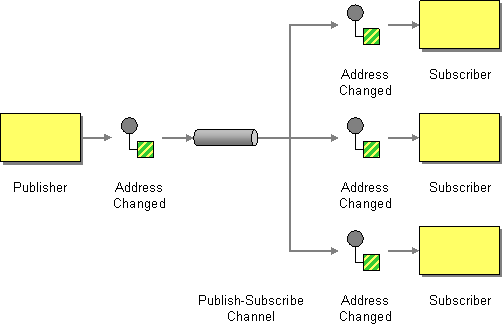此内容没有您所选择的语言版本。
6.2. Publish-Subscribe Channel
Overview
A publish-subscribe channel, shown in Figure 6.2, “Publish Subscribe Channel Pattern”, is a message channel that enables multiple subscribers to consume any given message. This is in contrast with a point-to-point channel. Publish-subscribe channels are frequently used as a means of broadcasting events or notifications to multiple subscribers.
Figure 6.2. Publish Subscribe Channel Pattern

Components that support publish-subscribe channel
The following Apache Camel components support the publish-subscribe channel pattern:
JMS
In JMS, a publish-subscribe channel is represented by a topic. For example, you can specify the endpoint URI for a JMS topic called
StockQuotes as follows:
jms:topic:StockQuotes
See Jms in the Apache Camel Component Reference Guide for more details.
ActiveMQ
In ActiveMQ, a publish-subscribe channel is represented by a topic. For example, you can specify the endpoint URI for an ActiveMQ topic called
StockQuotes, as follows:
activemq:topic:StockQuotes
See ActiveMQ in the Apache Camel Component Reference Guide for more details.
XMPP
The XMPP (Jabber) component supports the publish-subscribe channel pattern when it is used in the group communication mode. See Xmpp in the Apache Camel Component Reference Guide for more details.
Static subscription lists
If you prefer, you can also implement publish-subscribe logic within the Apache Camel application itself. A simple approach is to define a static subscription list, where the target endpoints are all explicitly listed at the end of the route. However, this approach is not as flexible as a JMS or ActiveMQ topic.
Java DSL example
The following Java DSL example shows how to simulate a publish-subscribe channel with a single publisher,
seda:a, and three subscribers, seda:b, seda:c, and seda:d:
from("seda:a").to("seda:b", "seda:c", "seda:d");Note
This only works for the InOnly message exchange pattern.
XML configuration example
The following example shows how to configure the same route in XML:
<camelContext id="buildStaticRecipientList" xmlns="http://camel.apache.org/schema/spring">
<route>
<from uri="seda:a"/>
<to uri="seda:b"/>
<to uri="seda:c"/>
<to uri="seda:d"/>
</route>
</camelContext>